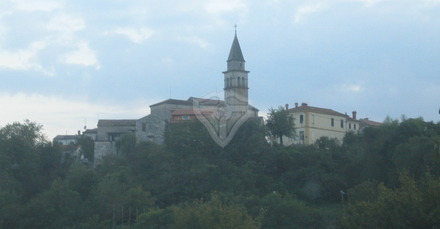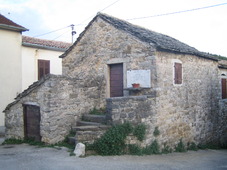to enlarge


or choose the place
from the menu below
 Rome |
 Byzantium |
 Venice |
 Vienna |
 Brioni |
 Smrikve |
 |
 |
 Beram is located in the central part of Istria, five kilometres
to the west of Pazin. You can reach to it by taking the road Pazin - Porec or from the directions of Porec and Motovun. It
is located on the 325 meters high hilltop and famous in Istria and abroad mostly for its fresco painting made by Vincent from
Kastav.
Beram is located in the central part of Istria, five kilometres
to the west of Pazin. You can reach to it by taking the road Pazin - Porec or from the directions of Porec and Motovun. It
is located on the 325 meters high hilltop and famous in Istria and abroad mostly for its fresco painting made by Vincent from
Kastav.





Beram is small and picturesque village, famous for its fresco paintings made by Vincent from Kastav at the end of the 15th century. The most famous scene is that named the Dance of Death.
BERAM – VIRTUAL TOUR
Once you arrive in the village you can park the car nearby the tavern Vela Vrata, at the entrance of the village, and start your visit of the village.
On top of the hill you will find the Parish Church of St. Martin that was built in 1431 and later on expanded and remodelled in 1910. The bell tower that you see nearby the Parish Church was built in 1903.
Numerous wall frescoes are visible within the church. The frescoes in the sanctuary were made during the erection of the church in the 15th century by some Master from Friuli (northern Italy), while those on the triumphal arch showing St. Michael and other Saints and the angelic musicians were made by a late Gothic Master from Venice.
The altar painting was done by the Croatian painter Celestin Mato Medovic at the beginning of the 20th century, while a rustical relief of St. Martin, hosted in the church, is from the late Gothic period.
 The Medieval settlement was defended by a strong rectangular tower that was demolished
in the 17th century and was located nearby the church.
The Medieval settlement was defended by a strong rectangular tower that was demolished
in the 17th century and was located nearby the church.
On the right side of the church you will note a small stone house with few stairs. This was the native house of Vladimir Gortan who was shot in Pula in 1929 because of his anti-fascist activity.
 The famous fresco paintings are hosted in the small Church of St. Mary on Skriljine
that is located about a kilometre from the old town centre, in the northeast direction.
The famous fresco paintings are hosted in the small Church of St. Mary on Skriljine
that is located about a kilometre from the old town centre, in the northeast direction.
If you have parked the car nearby the tavern at the entrance of the village you have to take the road that goes down side the hill and follow the road that goes on the right. St. Mary on Skriljine is located outside the village and you have to take the car to reach it.
Continue to drive until you arrive nearby a small stone pillar that was placed there in honour to Vincent from Kastav, the painter.